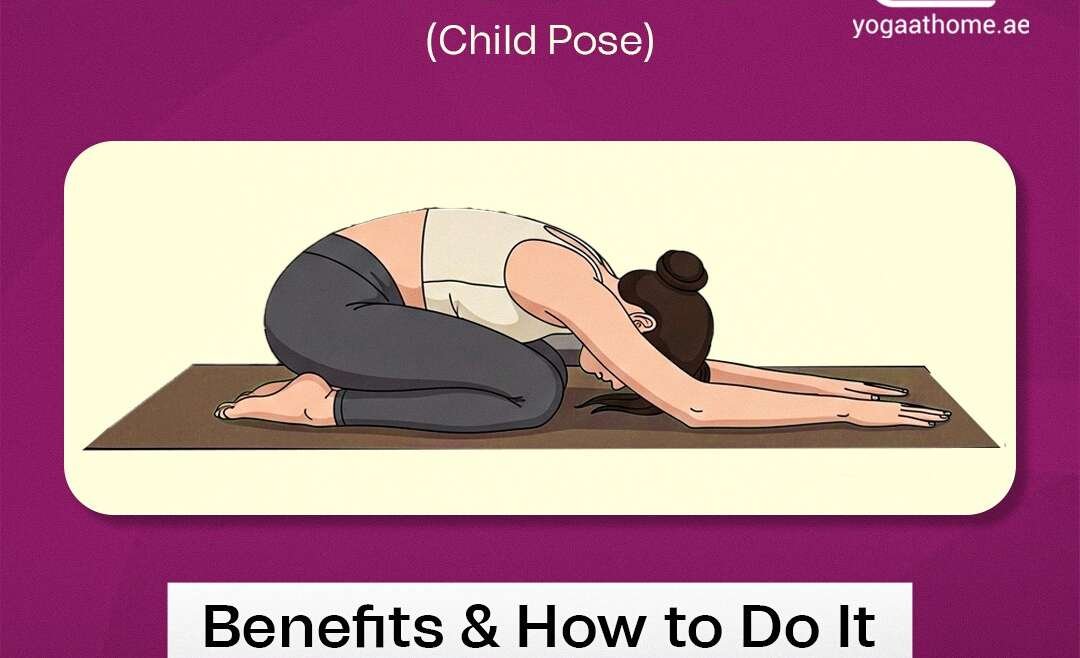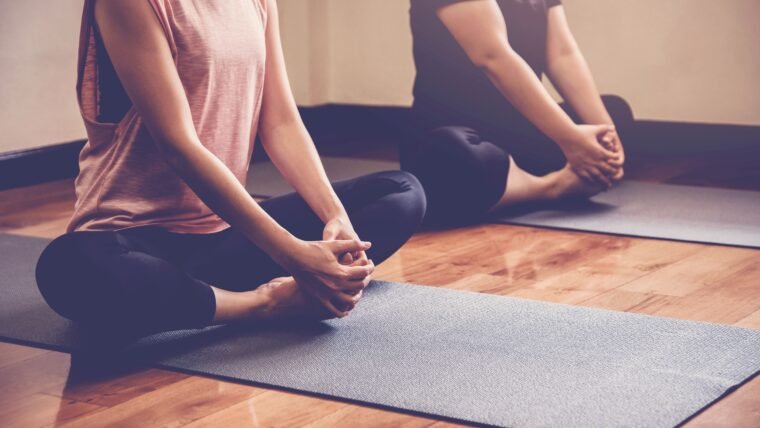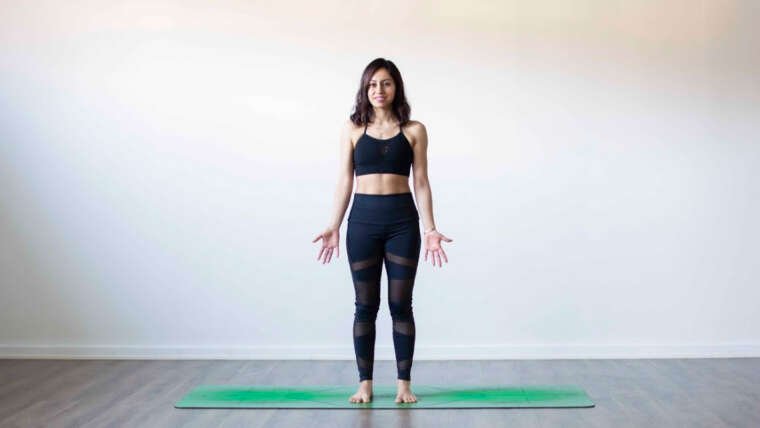Balasana (Child’s Pose): Benefits & How to Do It
Have you ever wanted to just pause and breathe? To hit a physical reset, unwind your spine, and soothe your mind, all in one gentle, grounding pose? Then Balasana, also known as Child’s Pose, is for you. It’s one of the most comforting, restorative postures in yoga. At Yoga at Home, we call it the “safe haven” of yoga because it offers instant relief when life feels overwhelming.
Balasana is about surrender, rest, and letting your body recover. It’s accessible to almost everyone, perfect for beginners or experienced yogis alike. Today, let’s dive deep into how to practice it, the many ways it benefits your body and mind, and how to explore meaningful variations.
What Is Balasana?
Balasana (from Sanskrit bala, meaning “child”) is a restful posture where you fold forward from your knees, with your forehead resting on the mat. Your arms may reach forward or lie alongside your body. It resembles a child curling into slumber, a natural and instinctive position that speaks to our earliest days.
In this pose, you create space in your back, calm your nervous system, and help your mind unwind. It’s a valuable pause between more active poses and a go-to posture when you need a moment, on and off the mat.
How to Do Balasana: Step-by-Step Guide
You don’t need a fancy studio or extra props. Just a yoga mat and a few minutes of quiet. Here’s how:
- Start on Your Hands and Knees
Sit on your heels with your knees hip-width apart. Bring your big toes together. - Fold Forward
Wrap your arms toward the front or rest them alongside your body. Gently lower your forehead or chin to the mat. - Settle Your Hips
Let your hips rest gently on your heels. If your hips don’t reach, place a folded blanket or block between your knees and hips. - Relax Your Body
Allow your shoulders to melt away from your ears. Unclench your jaw and soften your facial muscles. - Breathe Naturally
Take slow, mindful breaths. Feel each inhalation expand your back; each exhalation deepen your relaxation. - Hold the Pose
Stay here for 1–5 minutes or as long as your body asks. If your forehead lifts, support it with a blanket or block. - Rise Slowly
Inhale to lift your torso and return to hands and knees or roll up into a seated position. Move slowly and mindfully.
Why Balasana Is So Powerful
1. Release Tension in the Back and Spine
Balasana elongates your entire spine, relieving stiffness. It stretches your lower back and shoulders, offering immediate relief after long periods of sitting.
2. Calm the Mind
This posture activates the parasympathetic nervous system, your body’s relaxation response. It lowers your heart rate and soothes overcrowded thoughts. It’s perfect to reset before a challenging pose or winding down after a busy day.
3. Gentle Stretch for Hips & Thighs
Balasana opens your hips and stretches your thighs without strain. It’s an effective way to improve pelvic flexibility and comfort.
4. Supports Digestion
The light compression on your abdomen can stimulate digestion and reduce bloating. That calming effect can be helpful after a heavy meal (but not immediately after eating).
5. Eases Fatigue and Stress
When fatigue hits, mentally or physically, Balasana brings instant grounding. It’s a restful tool to use anytime stress mounts or energy needs recharging.
6. Restorative Reset Between Poses
Switching between dynamic postures? Balasana provides a brief restorative break. It helps you reconnect with your breath and attention.
Common Variations & Modifications
Balasana adapts beautifully to many bodies and situations:
- Wide-Legged Variation: Move your knees apart toward the mat’s edges, keeping big toes touching. This version eases pressure on the lower back and offers a deeper hip stretch.
- Supported Variation: Rest your torso on a bolster or folded blanket, and place one under your forehead if lifting feels uncomfortable.
- Arm Variations:
- Classic: Arms stretch out before you, palms down, deep stretch for shoulders and upper back.
- Rest: Arms sit by your sides, palms up, great for shoulder relief and deeper relaxation.
- Head Lift Option: Place a block under your forehead. It supports neck comfort, ideal for beginners or those with cervical tension.
- Pregnancy Adjustments: Widen your knees to make space for your belly. Support your chest and forehead with props.
- Knee Sensitivity: Cushion your knees with a towel or blanket, or sit slightly higher on a bolster to reduce strain.
Who Should Be Cautious
Balasana is extremely safe, but always check in with your body:
- Knee pain or recent injury: Use padding or sit higher on a bolster.
- Pregnancy: Widen your knees and use support under your torso.
- Recent torso surgery or hernia: Practice only with doctor’s approval.
- Severe rotator cuff or shoulder injuries: Keep your arms by your sides and move slowly.
Tips for a Restorative Experience
- Set an Intention
Before you begin, choose a word or visualization (like “peace” or “letting go”). Gently repeat it with each inhale and exhale. - Extend Your Breath
Try inhaling and exhaling for counts of 4 or 6. Even small changes in breath can dramatically shift your inner state. - Add Soothing Scents or Sounds
Light a candle, burn incense, or use soft instrumental music or nature sounds to deepen relaxation. - Pair with Guided Meditation
Balasana is ideal for a short guided meditation. Visualize warmth or healing in your body. - Use It Off the Mat
Stuck in front of a screen? A mini Balasana break (even sitting with folded hands and a bowed head) can relieve stress and realign posture instantly.
Balasana & Yoga at Home: Expert Support Where It Matters
Even a simple pause like Child’s Pose can feel more powerful with expert guidance. If you’re new to yoga or returning after a break, Yoga at Home offers online sessions and personalized plans to help you:
- Find the best variants for your body
- Learn how to use props like bolsters and blocks
- Create a balanced flow that includes recovery postures like Balasana
- Embed intention and breathing into each practice
We believe yoga should support your everyday life, calming, healing, and strengthening you in your own space.
Final Thoughts
In yoga, less isn’t less, especially when less means more spacious, mindful presence. Balasana shows us that profound change often comes through stillness. When you fold forward, breathe deeply, and allow your body to relax, you create space, physically and mentally, for renewal.
Begin your session or end a long day with just a minute in Child’s Pose. Let the world slow down. Feel your spine soften. Trust that in your pause, you’re doing exactly what you need.
Ready to bring this calm into your daily routine? Join Yoga at Home with a 50% off on your first trial session. Already with us? Then refer a friend and get 20% off your next class. Let’s grow calm together!



